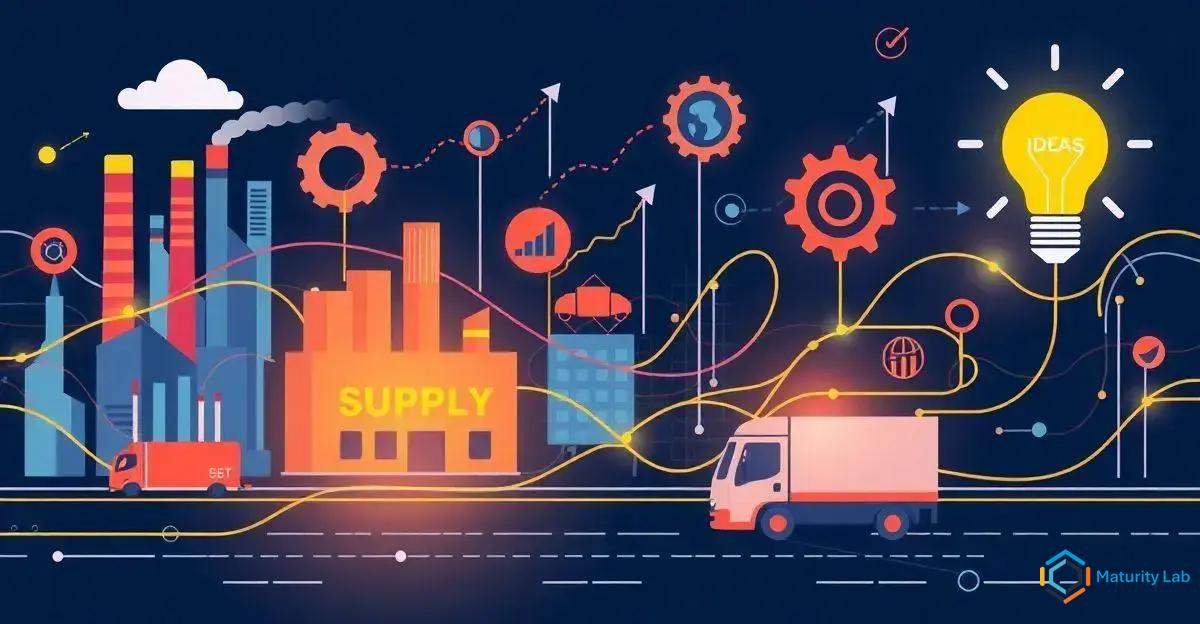The Supply Chain Maturity Model (SCMM) is a framework that helps organizations assess and improve their supply chain capabilities through effective process management, technology integration, and continuous improvement strategies. Key components include performance measurement, supplier relationship management, and risk management. To implement SCMM, organizations should conduct a maturity assessment, set clear objectives, develop an action plan, engage stakeholders, invest in technology, and foster a culture of continuous improvement, ultimately leading to enhanced efficiency and competitive advantage.
In today’s competitive business environment, effective supply monitoring and continuous improvement are critical for maintaining a robust supply chain. The Supply Chain Maturity Model (SCMM) offers a structured approach to evaluate and enhance supply chain processes. By leveraging SCMM, organizations can identify areas for improvement, implement best practices, and achieve sustainable growth. This article delves into the intricacies of SCMM, supply monitoring, and continuous improvement, providing valuable insights for businesses aiming to optimize their supply chain operations.
Understanding SCMM and Its Importance

The Supply Chain Maturity Model (SCMM) is a framework designed to assess and enhance the capabilities of an organization’s supply chain. It provides a structured approach to evaluate current practices, identify gaps, and implement improvements. The SCMM is essential for organizations seeking to optimize their supply chain operations, reduce costs, and improve overall efficiency.
At its core, SCMM focuses on several key dimensions, including process management, technology integration, performance measurement, and continuous improvement. By evaluating these dimensions, organizations can gain a comprehensive understanding of their supply chain’s maturity level and identify areas for enhancement.
One of the primary benefits of SCMM is its ability to provide a clear roadmap for improvement. Organizations can use the model to set realistic goals, prioritize initiatives, and track progress over time. This structured approach ensures that improvements are sustainable and aligned with the organization’s strategic objectives.
Furthermore, SCMM emphasizes the importance of continuous improvement. In a rapidly changing business environment, supply chains must be agile and adaptable. The SCMM framework encourages organizations to regularly review and update their processes, ensuring they remain competitive and responsive to market demands.
For example, a company might use SCMM to evaluate its inventory management practices. By identifying inefficiencies and implementing best practices, the company can reduce stockouts, minimize excess inventory, and improve customer satisfaction. This not only enhances operational efficiency but also contributes to the organization’s bottom line.
In conclusion, understanding SCMM and its importance is crucial for organizations aiming to optimize their supply chain operations. By leveraging the SCMM framework, businesses can achieve sustainable growth, improve efficiency, and maintain a competitive edge in the market.
Key Components of Effective Supply Monitoring

Effective supply monitoring is a critical aspect of maintaining a robust and efficient supply chain. It involves a systematic approach to tracking and managing various elements of the supply chain to ensure optimal performance. The key components of effective supply monitoring include:
1. Data Collection and Analysis
Accurate and timely data collection is the foundation of effective supply monitoring. Organizations must gather data from various sources, including suppliers, logistics providers, and internal systems. This data should be analyzed to identify trends, detect anomalies, and make informed decisions. Advanced analytics tools and techniques, such as predictive analytics and machine learning, can enhance the accuracy and reliability of supply chain data.
2. Performance Metrics
Establishing clear performance metrics is essential for monitoring supply chain performance. Key performance indicators (KPIs) such as lead time, order accuracy, inventory turnover, and supplier reliability provide valuable insights into the efficiency and effectiveness of supply chain operations. Regularly reviewing these metrics helps organizations identify areas for improvement and take corrective actions.
3. Supplier Relationship Management
Strong relationships with suppliers are crucial for effective supply monitoring. Organizations should work closely with their suppliers to ensure timely deliveries, high-quality products, and reliable service. This involves regular communication, performance reviews, and collaborative problem-solving. Building trust and transparency with suppliers can lead to improved performance and reduced risks.
4. Risk Management
Supply chain risks, such as disruptions, delays, and quality issues, can have significant impacts on operations. Effective supply monitoring involves identifying potential risks, assessing their likelihood and impact, and implementing mitigation strategies. This may include diversifying suppliers, maintaining safety stock, and developing contingency plans to ensure continuity of supply.
5. Technology Integration
Leveraging technology is essential for effective supply monitoring. Advanced technologies such as Internet of Things (IoT) devices, blockchain, and artificial intelligence (AI) can provide real-time visibility into supply chain operations. These technologies enable organizations to track shipments, monitor inventory levels, and ensure compliance with regulatory requirements. Integrating technology into supply chain processes enhances efficiency, accuracy, and responsiveness.
6. Continuous Improvement
Continuous improvement is a key component of effective supply monitoring. Organizations should regularly review their supply chain processes, identify areas for enhancement, and implement best practices. This involves fostering a culture of innovation, encouraging feedback from stakeholders, and staying abreast of industry trends and advancements. Continuous improvement ensures that supply chain operations remain competitive and adaptable to changing market conditions.
In summary, effective supply monitoring involves a comprehensive approach that encompasses data collection and analysis, performance metrics, supplier relationship management, risk management, technology integration, and continuous improvement. By focusing on these key components, organizations can optimize their supply chain operations, reduce costs, and enhance overall performance.
Strategies for Continuous Improvement in Supply Chains

Strategies for Continuous Improvement in Supply Chains
Continuous improvement in supply chains is essential for maintaining competitiveness and achieving operational excellence. Implementing effective strategies can help organizations identify inefficiencies, enhance processes, and adapt to changing market conditions. The following strategies are critical for fostering continuous improvement in supply chains:
1. Lean Management
Lean management focuses on eliminating waste and optimizing processes to create value for customers. By adopting lean principles, organizations can streamline their supply chain operations, reduce lead times, and improve quality. Techniques such as value stream mapping, 5S, and Kaizen can help identify and eliminate non-value-added activities, leading to more efficient and cost-effective supply chains.
2. Six Sigma
Six Sigma is a data-driven methodology aimed at reducing defects and variability in processes. By implementing Six Sigma techniques, organizations can improve the quality and consistency of their supply chain operations. The DMAIC (Define, Measure, Analyze, Improve, Control) framework provides a structured approach to problem-solving and process improvement, ensuring that changes are sustainable and aligned with business objectives.
3. Total Quality Management (TQM)
Total Quality Management (TQM) is a holistic approach to continuous improvement that involves all employees in the organization. TQM emphasizes customer satisfaction, process improvement, and employee involvement. By fostering a culture of quality and encouraging collaboration, organizations can enhance their supply chain performance and achieve long-term success.
4. Benchmarking
Benchmarking involves comparing an organization’s supply chain performance against industry standards or best practices. By identifying gaps and areas for improvement, organizations can implement strategies to enhance their operations. Benchmarking provides valuable insights into competitive positioning and helps organizations set realistic goals for continuous improvement.
5. Supplier Collaboration
Collaborating with suppliers is crucial for continuous improvement in supply chains. Organizations should work closely with their suppliers to identify opportunities for process optimization, cost reduction, and innovation. Joint improvement initiatives, regular performance reviews, and open communication can lead to mutually beneficial outcomes and stronger supply chain partnerships.
6. Technology Adoption
Embracing advanced technologies is essential for continuous improvement in supply chains. Technologies such as artificial intelligence (AI), blockchain, and the Internet of Things (IoT) can provide real-time visibility, enhance decision-making, and improve efficiency. By integrating these technologies into their supply chain processes, organizations can stay ahead of industry trends and drive continuous improvement.
7. Employee Training and Development
Investing in employee training and development is critical for fostering a culture of continuous improvement. Organizations should provide ongoing training programs to enhance employees’ skills and knowledge. Encouraging employees to participate in improvement initiatives and providing them with the necessary tools and resources can lead to more innovative and effective supply chain processes.
8. Performance Measurement and Feedback
Regularly measuring and reviewing supply chain performance is essential for continuous improvement. Organizations should establish clear performance metrics and conduct regular assessments to identify areas for enhancement. Gathering feedback from stakeholders, including customers, suppliers, and employees, can provide valuable insights and drive improvements.
In conclusion, implementing strategies for continuous improvement in supply chains involves adopting lean management, Six Sigma, TQM, benchmarking, supplier collaboration, technology adoption, employee training, and performance measurement. By focusing on these strategies, organizations can optimize their supply chain operations, enhance efficiency, and achieve sustainable growth.
Implementing SCMM for Long-Term Success

Implementing the Supply Chain Maturity Model (SCMM) effectively can lead to long-term success and sustainability for organizations. The SCMM provides a structured framework to assess, improve, and optimize supply chain processes. The following steps outline a comprehensive approach to implementing SCMM for long-term success:
1. Conduct a Maturity Assessment
The first step in implementing SCMM is to conduct a thorough maturity assessment of the organization’s current supply chain processes. This involves evaluating key dimensions such as process management, technology integration, performance measurement, and continuous improvement. The assessment helps identify strengths, weaknesses, and areas for improvement, providing a baseline for future enhancements.
2. Define Clear Objectives and Goals
Establishing clear objectives and goals is crucial for successful SCMM implementation. Organizations should align their supply chain improvement initiatives with their strategic objectives. Setting specific, measurable, achievable, relevant, and time-bound (SMART) goals ensures that efforts are focused and progress can be tracked effectively.
3. Develop an Action Plan
Based on the maturity assessment and defined goals, organizations should develop a detailed action plan. This plan should outline the steps required to achieve the desired maturity level, including process improvements, technology upgrades, and training programs. Assigning responsibilities and setting timelines ensures accountability and facilitates smooth implementation.
4. Engage Stakeholders
Successful SCMM implementation requires the involvement and commitment of all stakeholders, including employees, suppliers, and customers. Engaging stakeholders through regular communication, collaboration, and feedback helps build support and ensures that improvement initiatives are aligned with their needs and expectations. Creating cross-functional teams can enhance collaboration and drive more effective implementation.
5. Invest in Technology
Technology plays a critical role in achieving supply chain maturity. Organizations should invest in advanced technologies such as artificial intelligence (AI), blockchain, and the Internet of Things (IoT) to enhance visibility, efficiency, and decision-making. Integrating these technologies into supply chain processes can provide real-time insights, automate routine tasks, and improve overall performance.
6. Monitor and Measure Progress
Continuous monitoring and measurement of progress are essential for long-term success. Organizations should establish key performance indicators (KPIs) to track the effectiveness of their SCMM implementation. Regularly reviewing these metrics helps identify areas for further improvement and ensures that the organization remains on track to achieve its goals.
7. Foster a Culture of Continuous Improvement
A culture of continuous improvement is vital for sustaining long-term success. Organizations should encourage employees to embrace change, seek out opportunities for improvement, and contribute to innovation. Providing ongoing training and development programs helps build the skills and knowledge required to drive continuous improvement initiatives.
8. Review and Update the SCMM Framework
The business environment is constantly evolving, and supply chain processes must adapt accordingly. Organizations should regularly review and update their SCMM framework to ensure it remains relevant and effective. This involves staying abreast of industry trends, technological advancements, and best practices. Periodic reassessments help maintain alignment with strategic objectives and drive sustained success.
In summary, implementing SCMM for long-term success involves conducting a maturity assessment, defining clear objectives, developing an action plan, engaging stakeholders, investing in technology, monitoring progress, fostering a culture of continuous improvement, and regularly updating the SCMM framework. By following these steps, organizations can optimize their supply chain operations, achieve sustainable growth, and maintain a competitive edge.
In conclusion, the Supply Chain Maturity Model (SCMM) serves as an invaluable framework for organizations striving to enhance their supply chain operations.
By understanding SCMM and its importance, businesses can identify key areas for improvement and implement structured strategies to achieve long-term success.
Effective supply monitoring, characterized by comprehensive data collection, performance metrics, supplier relationship management, risk management, technology integration, and continuous improvement, is fundamental to maintaining a robust supply chain.
Furthermore, adopting strategies for continuous improvement, such as lean management, Six Sigma, Total Quality Management (TQM), benchmarking, supplier collaboration, technology adoption, and employee training, ensures that supply chains remain efficient and adaptable to changing market conditions.
Implementing SCMM
Implementing SCMM involves conducting a maturity assessment, defining clear objectives, developing an action plan, engaging stakeholders, investing in technology, monitoring progress, fostering a culture of continuous improvement, and regularly updating the SCMM framework.
By following these comprehensive steps, organizations can optimize their supply chain processes, reduce costs, enhance efficiency, and achieve sustainable growth.
The SCMM not only provides a clear roadmap for improvement but also encourages a proactive approach to managing supply chain challenges.
As businesses continue to navigate the complexities of the global market, leveraging the SCMM framework will be instrumental in maintaining a competitive edge and driving long-term success.
Frequently Asked Questions about SCMM, Supply Monitoring, and Continuous Improvement
What is the Supply Chain Maturity Model (SCMM)?
The Supply Chain Maturity Model (SCMM) is a framework designed to assess and enhance the capabilities of an organization’s supply chain. It evaluates key dimensions such as process management, technology integration, performance measurement, and continuous improvement to identify areas for enhancement.
Why is effective supply monitoring important?
Effective supply monitoring is crucial for maintaining a robust and efficient supply chain. It involves systematic tracking and management of various supply chain elements to ensure optimal performance, reduce costs, and improve overall efficiency.
What are the key components of effective supply monitoring?
The key components of effective supply monitoring include data collection and analysis, performance metrics, supplier relationship management, risk management, technology integration, and continuous improvement.
How can organizations achieve continuous improvement in supply chains?
Organizations can achieve continuous improvement in supply chains by adopting strategies such as lean management, Six Sigma, Total Quality Management (TQM), benchmarking, supplier collaboration, technology adoption, and employee training and development.
What steps are involved in implementing SCMM for long-term success?
Implementing SCMM for long-term success involves conducting a maturity assessment, defining clear objectives, developing an action plan, engaging stakeholders, investing in technology, monitoring progress, fostering a culture of continuous improvement, and regularly updating the SCMM framework.
How does technology integration enhance supply chain monitoring?
Technology integration enhances supply chain monitoring by providing real-time visibility, improving decision-making, and increasing efficiency. Advanced technologies such as artificial intelligence (AI), blockchain, and the Internet of Things (IoT) enable organizations to track shipments, monitor inventory levels, and ensure regulatory compliance.

